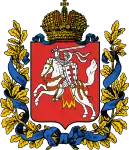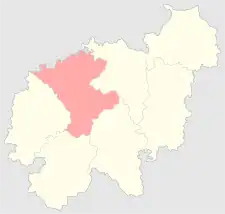Vilensky Uezd
The Vilna uezd[lower-alpha 1] was a county (uezd) of the Vilna Governorate of the Russian Empire, with the administrative centre in Vilna (which is in modern-day Vilnius). The uezd was bordered by the Sventsyany uezd to the east, the Oshmyany and Lida uezds to the south, the Troki uezd to the west, and the Vilkomir uezd of the Kovno Governorate to the north. The district covered the area of modern Vilnius County of Lithuania.
Vilna uezd
Виленскій уѣздъ | |
|---|---|
 Coat of arms | |
 Location in the Vilna Governorate | |
| Country | Russian Empire |
| Krai | Northwestern |
| Governorate | Vilna |
| Established | 1795 |
| Abolished | 1920 |
| Capital | Vilna |
| Area | |
| • Total | 6,185.14 km2 (2,388.10 sq mi) |
| Population (1897) | |
| • Total | 363,313 |
| • Density | 59/km2 (150/sq mi) |
| • Urban | 42.53% |
| • Rural | 57.47% |
History
A part of the Polish–Lithuanian Commonwealth, the Vilnius Voivodeship was annexed by the Russian Empire as a part of the Partitions of Poland. In 1796, the Lithuania Governorate was established, which included the Vilna uezd, and later became a part of the Litva-Vilna Governorate.
The Russian rule on Vilnius land came to an end ephemerally in 1915 when Imperial Germany established the Supreme Commander of All German Forces in the East, also known as Ober-Ost, followed by the Kingdom of Lithuania. After the Polish occupation, the Soviet authorities formally abolished it in 1924.
Administrative divisions
The subcounties (volosts) of the Vilna uezd in 1912 were as follows:[1]
| Name | Name in Russian | Capital |
|---|---|---|
| Bystritsa volost | Быстрицкая волость | Bystritsa |
| Vornyany volost | Ворнянская волость | Vornyany |
| Gedroytsy volost | Гедройцкая волость | Gedroytsy |
| Gelvany volost | Гелванская волость | Gelvany |
| Ilyino volost | Ильинская волость | Ilyino |
| Malyaty volost | Малятская волость | Malyaty |
| Meyshagola volost | Мейшагольская волость | Meyshagola |
| Mitskuny volost | Мицкунская волость | Mitskuny |
| Musniki volost | Мусникская волость | Musniki |
| Nemenchin volost | Неменчинская волость | Nemenchin |
| Podberezye volost | Подберезская волость | Podberezye |
| Rudomino volost | Рудоминская волость | Rudomino |
| Rukoyni volost | Рукойнская волость | Rukoyni |
| Resha volost | Рѣшанская волость | Resha |
| Solechniki volost | Солечникская волость | Malye Solechniki |
| Shirvinty volost | Ширвинтская волость | Shirvinty |
| Shumsk volost | Шумская волость | Shumsk |
| Yanishki volost | Янишская волость | Yanishki |
Demographics
Russian Empire Census
At the time of the Russian Empire Census on 28 January [O.S. 15 January] 1897, the Vilna uezd had a population of 363,313 (with the city of Vilnius included), including 183,598 men and 179,915 women. The majority of the population indicated White Russian to be their mother tongue, which followed by Jewish, Lithuanian, and Polish speakers.[2]
| Language | Native speakers | Percentage |
|---|---|---|
| White Russian[lower-alpha 2] | 93,896 | 25.84 |
| Jewish | 77,224 | 21.26 |
| Lithuanian | 76,030 | 20.93 |
| Polish | 73,088 | 20.12 |
| Great Russian[lower-alpha 2] | 37,906 | 10.43 |
| German | 2,844 | 0.78 |
| Tatar | 771 | 0.21 |
| Little Russian[lower-alpha 2] | 557 | 0.15 |
| Latvian | 211 | 0.06 |
| Gypsy | 15 | 0.00 |
| Others | 771 | 0.21 |
| Total | 363,313 | 100.00 |
Notes
-
- Russian: Ви́ленскій уѣ́здъ, romanized: Vílenskiy uyézd
- Lithuanian: Vilniaus apskritis
- Prior to 1918, the Imperial Russian Government classified Russians as the Great Russians, Ukrainians as the Little Russians, and Belarusians as the White Russians. After the creation of the Ukrainian People's Republic in 1918, the Little Russians identified themselves as "Ukrainian".[3] Also, the Belarusian Democratic Republic which the White Russians identified themselves as "Belarusian".[4]
References
- Волостныя, станичныя, сельския, гминныя правления и управления, а также полицейские станы всей России с обозначением места их нахождения [Volostny, stanichnaya, rural, communes of government and administration, as well as police camps throughout Russia with the designation of their location]. Kiev: Izd-vo T-va L. M. Fish. 1913. p. 112. Archived from the original on 2022-12-11.
- "Демоскоп Weekly - Приложение. Справочник статистических показателей". www.demoscope.ru. Retrieved 2018-06-08.
- Hamm, Michael F. (2014). Kiev: A Portrait, 1800–1917. Princeton University Press. p. 83. ISBN 978-1-4008-5151-5.
- Fortson IV, Benjamin W. (2011). Indo-European Language and Culture: An Introduction. John Wiley & Sons. p. 429. ISBN 978-1-4443-5968-8.